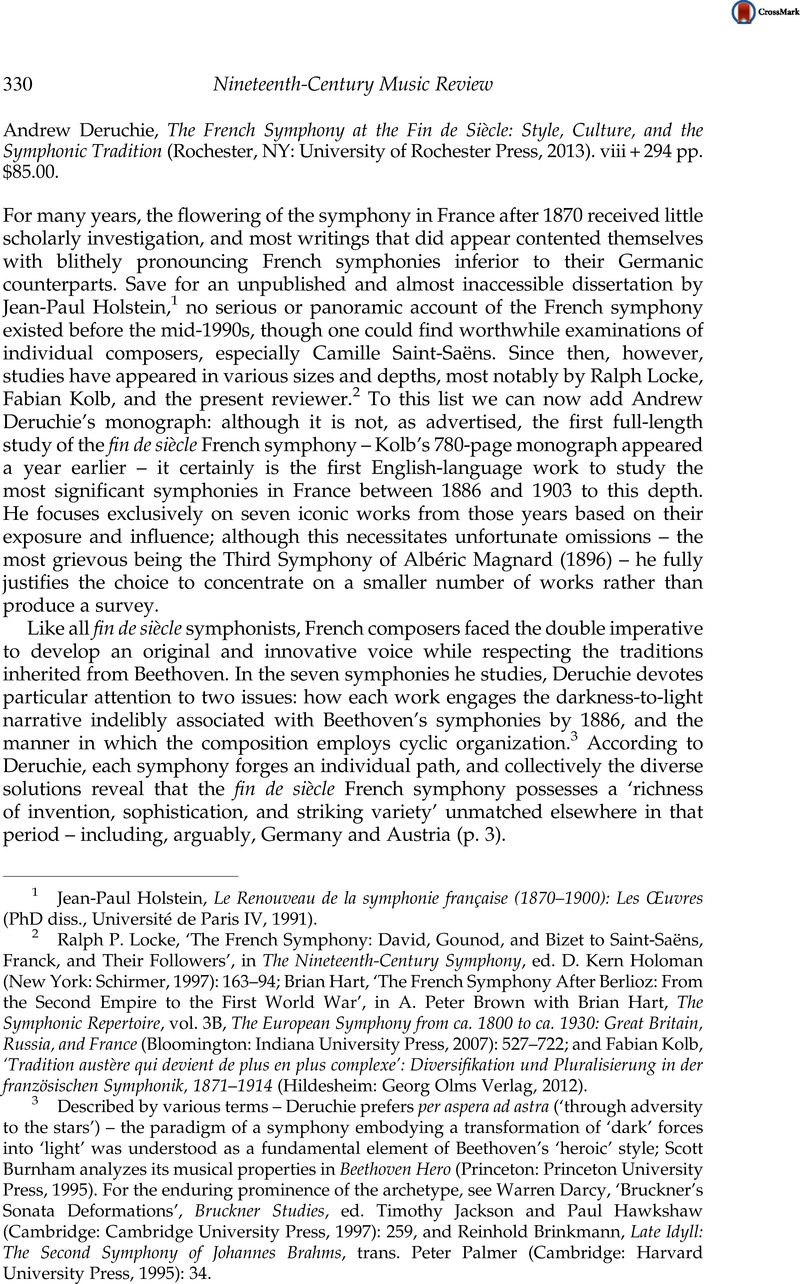No CrossRef data available.
Article contents
Andrew Deruchie, The French Symphony at the Fin de Siècle: Style, Culture, and the Symphonic Tradition (Rochester, NY: University of Rochester Press, 2013). viii + 294 pp. $85.00.
Published online by Cambridge University Press: 01 July 2015
Abstract

- Type
- Book Reviews
- Information
- Copyright
- © Cambridge University Press 2015
References
1 Holstein, Jean-Paul, Le Renouveau de la symphonie française (1870–1900): Les Œuvres (PhD diss., Université de Paris IV, 1991)Google Scholar.
2 Locke, Ralph P., ‘The French Symphony: David, Gounod, and Bizet to Saint-Saëns, Franck, and Their Followers’, in The Nineteenth-Century Symphony, ed. D. Kern Holoman (New York: Schirmer, 1997): 163–194Google Scholar; Hart, Brian, ‘The French Symphony After Berlioz: From the Second Empire to the First World War’, in A. Peter Brown with Brian Hart, The Symphonic Repertoire, vol. 3B, The European Symphony from ca. 1800 to ca. 1930: Great Britain, Russia, and France (Bloomington: Indiana University Press, 2007): 527–722Google Scholar; and Kolb, Fabian, ‘Tradition austère qui devient de plus en plus complexe’: Diversifikation und Pluralisierung in der französischen Symphonik, 1871–1914 (Hildesheim: Georg Olms Verlag, 2012)Google Scholar.
3 Described by various terms – Deruchie prefers per aspera ad astra (‘through adversity to the stars’) – the paradigm of a symphony embodying a transformation of ‘dark’ forces into ‘light’ was understood as a fundamental element of Beethoven’s ‘heroic’ style; Burnham, Scott analyzes its musical properties in Beethoven Hero (Princeton: Princeton University Press, 1995)Google Scholar. For the enduring prominence of the archetype, see Darcy, Warren, ‘Bruckner’s Sonata Deformations’, Bruckner Studies, ed. Timothy Jackson and Paul Hawkshaw (Cambridge: Cambridge University Press, 1997): 259Google Scholar, and Brinkmann, Reinhold, Late Idyll: The Second Symphony of Johannes Brahms, trans. Peter Palmer (Cambridge: Harvard University Press, 1995): 34Google Scholar.
4 For Liszt’s ‘two-dimensional form’ see Moortele, Steven Vande, Two Dimensional Sonata Form: Form and Cycle in Single-Movement Instrumental Works by Liszt, Strauss, Schoenberg, and Zemlinsky (Leuven: Leuven University Press, 2009)Google Scholar.
5 René de Castéra, ‘La Symphonie en si bémol de Vincent d’Indy’, L’Occident (April 1904): 174–5.
6 Deruchie, Andrew, The French Symphony at the Fin de Siècle: Style, Culture, and the Symphonic Tradition (PhD diss., McGill University, 2008)Google Scholar.



